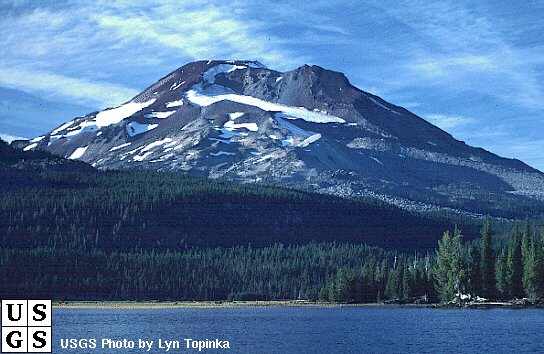 South Sister is the 3rd highest peak in Oregon, with the
highest lake in Oregon contained in its almost perfect summit crater. Hodge (1925) has a superb description of the mountain.
South Sister is the 3rd highest peak in Oregon, with the
highest lake in Oregon contained in its almost perfect summit crater. Hodge (1925) has a superb description of the mountain. South Sister
South Sister (10,358’):
 South Sister is the 3rd highest peak in Oregon, with the
highest lake in Oregon contained in its almost perfect summit crater. Hodge (1925) has a superb description of the mountain.
South Sister is the 3rd highest peak in Oregon, with the
highest lake in Oregon contained in its almost perfect summit crater. Hodge (1925) has a superb description of the mountain.
The South Sister is the youngest of the Three Sisters. It, however, is not a unified peak, but is a comparatively
young mountain built upon and around the wrecked remains of an ancient Elder
South Sister. Neither of these
South Sisters is comparable in great age to the North Sister. If it were possible to rename these peaks at the present
time, the North Sister should be called the Mother, and the Middle and South
Sisters Daughters. The South
Sister, by reason of its youth, is the most symmetrical mountain in the group.
The Elder South Sister, which protrudes through its Eastern slope,
disfigures its almost perfect shape. Here
we see that a mountain, like a human being, contains within itself part of its
ancestors.
Since the last ice age, South Sister has produced several pumice and obsidian flows on its South and East sides. The mountain could still be active, but there is no record of any activity since European settlements have been near the mountain.
South Sister has quite a number of permanent snowfields and several
glaciers, the most important of which is Prouty Glacier on the Northeast side.
The North side was extensively altered by glaciation in the past, but the
current Skinner and Eugene glaciers are much too small to be of any consequence
in the process now.
Descent via North Ridge:
We’ll descend the North Ridge.
North Ridge:
The North Ridge is the best route for parties wishing to approach South
Sister from the North, including climbers trying to complete a Sisters Marathon.
Most of the North Ridge is a grunt up a typical volcanic ridge.
The crux of the climb is moving around the right (West) side of a large
rock buttress at about 9,800 feet. Above
the buttress, follow the lower-angle slope to the summit.
Interesting Features:
The unpublished diary of Adolph Dekum indicates that the summit
of South Sister might have been used for religious purposes by Indians.
In 1883, Adolph Dekum noted stacks of rock on the summit, some of them
5-6 feet high. He found similar
rock structures on Bachelor butte, Maiden Peak, and Bald Peter. The rock piles described by Dekum may have been left over
from what anthropologists call a vision quest.
Since the vision quest was characteristic of most if not all Northwest
Indian tribes, it is impossible to say which tribe was responsible for the
structures. Nonetheless, here is an
excerpt from a book published by and anthropologist named Spier in 1930.
Power is sought from a host of spirits whose characteristics are not
sharply defined. These are
predominantly birds and animals, winds, lightning and the like… There are
times that are especially propitious; at puberty, in distress, or on the loss of
a wife, a husband, or child. The
mode of seeking and the revelation are stereotyped: one fasts at night on
mountaintops, running about, piling up rocks.